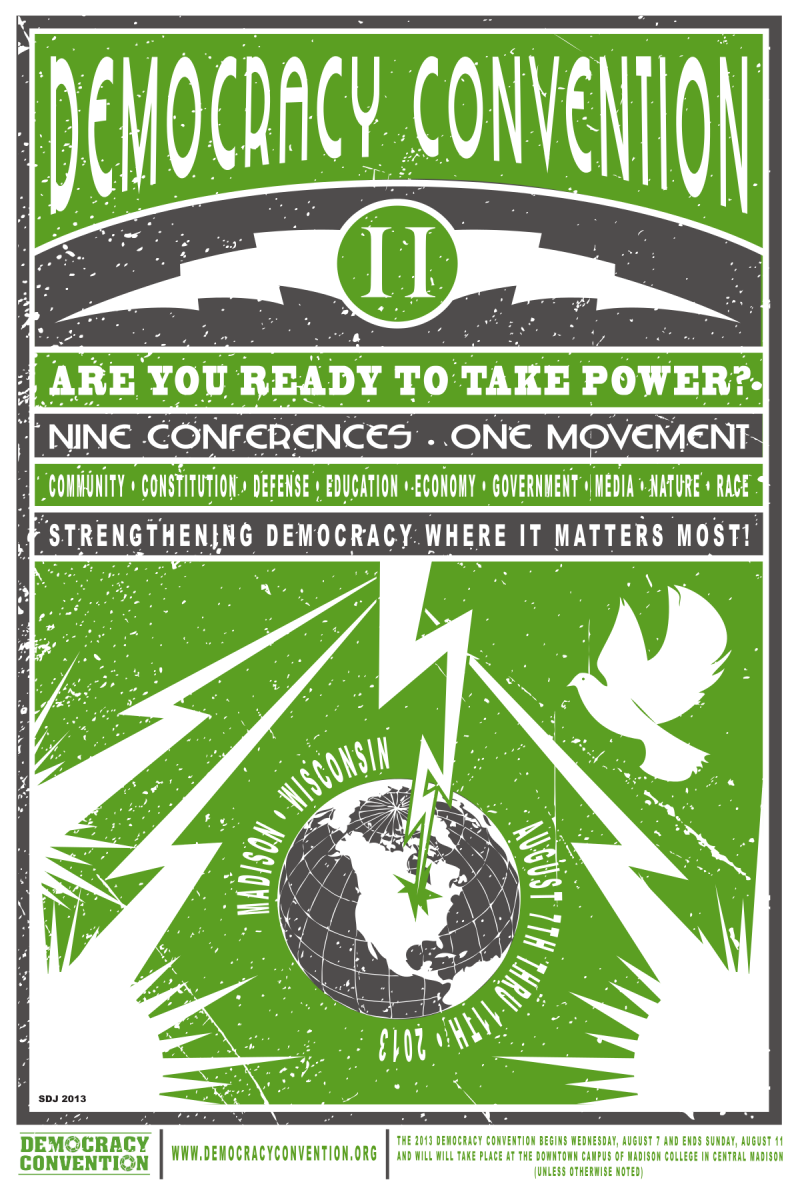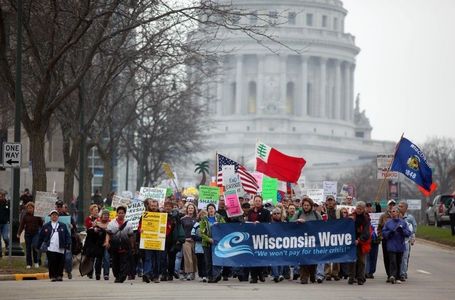Democracy Convention
Democracy is coming... to the U.S.A.
Wisconsin Uprising, Democracy Convention
“On Valentine’s Day, February 14th 2011, eleven hundred students and teachers from the University of Wisconsin and Madison Area Technical College entered Wisconsin’s Capitol in protest of a proposed state budget and so-called ‘Budget Repair Bill.’ By the next evening, upwards of ten thousand people had joined the protest and begun occupying the Capitol Building. Within days the crowds on the Capitol Square swelled to 30,000, and then 50,000, and eventually 150,000, giving global visibility to the six-month period of mass sit-ins, political strikes, encampments, assemblies, recall elections, marches and rallies known today as the Wisconsin Uprising.” (Excerpted from Ben Manski’s When Uprisings Aren’t Spontaneous: The Wisconsin Uprising as a product of movements in struggle).
The Wisconsin Uprising was not entirely spontaneous, but instead, the result both of decades of movement building activity by many groups and individuals as well as of deliberate organizing and action in the months and days leading up to the uprising coordinated by a Liberty Tree program begun in November of 2010, the Wisconsin Wave. On February 14th, as the first major Capitol protest began, the Wisconsin Wave became public with a statement signed by over 100 union, community, student, farm, and environmental leaders calling for a “Wisconsin Wave of Resistance Against Corporatization and Austerity and for Democracy and Shared Prosperity.”
Over the course of the following months, the Wisconsin Wave worked to build solidarity beyond the ranks of organized labor, to train activists in non-violent direct action escalation tactics, and to challenge directly the role of the Chamber of Commerce in promoting austerity in Wisconsin. The Wave made a series of critical interventions through mass rallies, direct actions, and the first popular assemblies of 2011 (a preview of Occupy). In early October of 2011, a delegation of Wisconsinites affiliated with the Wave led a ceremonial march into Freedom Plaza in Washington, D.C. in a mass occupation of public space that coincided with Occupy Wall Street. The Wisconsin Wave continued its organizing against the Chamber of Commerce and maintained a door-to-door canvassing operation and grassroots activist network until the end of 2015.
Even as the Wisconsin Uprising was underway, Wisconsinites continued their Move to Amend organizing, and began petitioning to place resolutions on municipal ballots calling for the adoption of Move to Amend’s We the People Amendment. As before with the anti-war resolutions of 2006, Liberty Tree provided support for this effort. On April 6, 2010, the voters of Madison, Wisconsin and of Dane County voted at rates of 82% and 78%, respectively, in favor of the Move to Amend resolutions, making those two localities the first among what are now over 600 municipal, county and state plebiscites and legislative resolutions in support of the provisions of the We the People Amendment.
 From August 24-28th of 2011, the first Democracy Convention took place in downtown Madison, Wisconsin, drawing nearly 1000 participants from 37 states and several countries. More than one conference, the Democracy Convention is a process involving many conferences under one roof. As the great reformer Fighting Bob La Follette said, “democracy is a life,” and “involves constant struggle” in all areas of society. The Democracy Conventions recognize the importance of each separate democracy struggle, as well as the need to unite them all in a common, deeply rooted, broad based, movement for democracy.
From August 24-28th of 2011, the first Democracy Convention took place in downtown Madison, Wisconsin, drawing nearly 1000 participants from 37 states and several countries. More than one conference, the Democracy Convention is a process involving many conferences under one roof. As the great reformer Fighting Bob La Follette said, “democracy is a life,” and “involves constant struggle” in all areas of society. The Democracy Conventions recognize the importance of each separate democracy struggle, as well as the need to unite them all in a common, deeply rooted, broad based, movement for democracy.
The conferences at the Democracy Convention are more than simply “tracks.” Because these conferences are gatherings of activist, networks, and organizations that are engaged in ongoing work together, each conference features plenaries, trainings, and decisionmaking sessions. Each conference is a project of one or more convening organizations; these conveners take responsibility for designing the program of their conference, recruiting presenters and participants, and coordinating with the conveners of other conferences. In 2011, the nine conferences of the Democracy Convention were the Constitutional Reform Conference, Democratizing Defense Conference, Economic Democracy Conference, Education for Democracy Conference, Local Democracy Conference, Media Democracy Conference, Race and Equality Conference and the Representative Democracy Conference.

